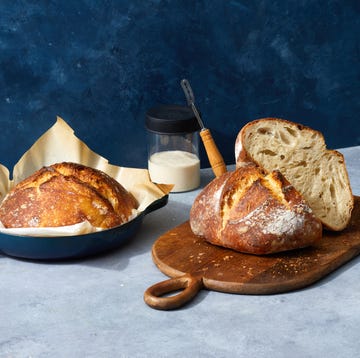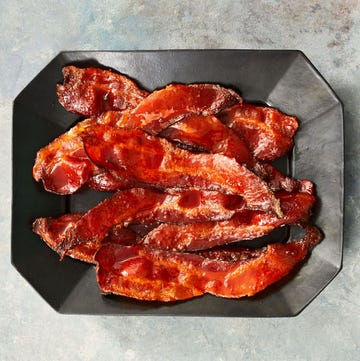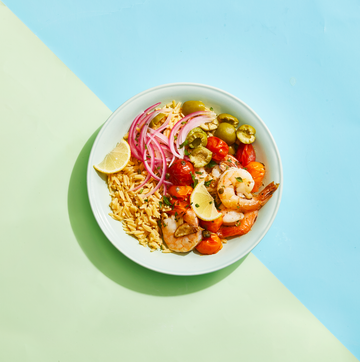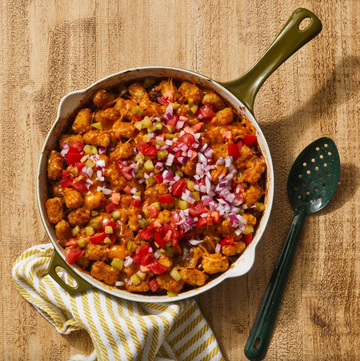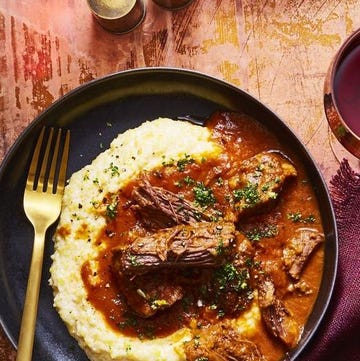Unlike true love, an open bottle of wine doesn’t last forever — but that doesn’t mean it has to be a one-night fling. Let’s say you opened a Pinot Noir and just had a glass; with the right conditions and maybe a handy preservation gadget, you can go on to enjoy what’s left in the bottle in a few days, or in some cases, in a few months.
What’s the deal with opened wine?
You’ve probably noticed that wine from an opened bottle on day two or three doesn’t taste the same as on day one. It can be a bit of a head-scratcher: The vino’s been sitting in that bottle all this time — why does it go downhill once we pull the cork (or unscrew the top)? “To get nerdy about it, let's look to science,” says Dana Beninati, host of Dine with Dana. “Exposure to oxygen is helpful immediately after opening a bottle.” She compares it to a morning yoga class after a long flight: “It allows a wine to unfurl and stretch into its full self after being cramped inside the bottle.” However, too much oxygen has adverse effects. “Extended exposure to air makes wine loose and flabby, rendering it incapable of expressing its true complexity,” Beninati explains.
How long will an open bottle of wine last?
“There are a ton of variables, but I would say open bottles of wine last anywhere from two to five days,” says Marie Cheslik, founder of Slik Wines, an online wine school and events platform. “In my experience, there are fewer noticeable changes with white wines; red wines, you notice more changes and with sparkling, you notice the most changes unless you have a sparkling wine closure.”
Beninati recommends enjoying still wines of all colors within three days of opening and sparkling wine within one day of opening. “Wine is drinkable beyond these timelines and certainly will not make you sick if consumed a week or two after opening, but it's beyond its prime.” She does add that these timelines can be extended slightly by proper storage.
How can you make an open bottle of wine last longer?
Close the wine bottle with a cork, cap or stopper
Cheslik has one basic rule: “Always reclose the wine in some capacity, whether using the cork, twist-off cap or a wine stopper.” A cork might be a limited, short-term solution, however. “I would say using the cork the bottle came with as the storage system won't let you enjoy the bottle more than after a day, most likely,” says Mariano Garay, wine director of Corima in New York City. “If you know you're going to drink it the next day, however, it's really not a problem in my book.” Beninati says you’ll get the strongest seal from a glass-top enclosure, which is a solid plug-like cap you sometimes see instead of a cork in a wine bottle.
Glass isn’t your only option for stoppers. There are flexible silicone stoppers, like the cone-shaped ones made by Rabbit, that can easily plug up a bottle. “I’ve tried the Rabbit stoppers and I felt like they perform well and are really cheap if you ever lose them,” says Garay. “I feel like I could get away with a day or two more, maximum, using them.”
Justin Mueller, consulting wine director for Choy in Nashville, Tennessee sets a common scenario: “You've finished enjoying your wine for the night but there's some left in the bottle, put the original cork back in and stick it in the fridge — even red wine.” He says this simple step will prolong the lifespan of the wine. “Sure, they make pumps and sprays to remove excess oxygen but unless you're trying to preserve that bottle for more than a few days, there's really no need.” He says his low-tech method is even fine for older [aged] bottles. “I opened a Mayacamas 1982 Cabernet for dinner with my wife recently, which we decided was not at the top of its game that night. We put it in the fridge and revisited it a day later — it was singing.” He adds that this is also a good way to trace a wine's evolution as it's exposed to oxygen over a few days.
Keep the wine in the fridge where it's dark
“Most people probably have experienced their white wines staying much fresher than their reds,” says Ashley Luna, director of food and beverage at Farmhouse Inn. The reason for that? The whites were stored in a dark fridge whereas the reds were kept on the counter, exposed to light, according to Luna. “Wines left out at room temperature, or even cellar temperature [which is cooler than room temp], will typically be fine the next day (sometimes even better),” he says. “However, on day two they will have lost a considerable step (but are still drinkable).” And by day three? “They start to be fairly oxidized and become unpleasant to drink.” He says that by simply refrigerating them, you will get an extra day or two out of this timeline and have a wine that is still good three to five days from when it was opened. “If it’s a red wine, pull it from the fridge 30 minutes from when you want to drink it and it will be a perfect cellar temperature.”
Pour leftover wine into smaller bottles
“There are a lot of expensive or one-trick tools out there that do the job or claim to,” says Emmeline Zhao, managing partner and sommelier of Figure Eight in New York City. But her favorite inexpensive hack is to pour the remaining wine into smaller bottles and keep it refrigerated. It’s all about minimizing the amount of oxygen that’s in contact with the wine. She suggests saving the next half-bottle of wine you buy or picking up empty 500-mL and 375-mL bottles online. “I've had a wine decanted into a 375-mL bottle and two weeks later, it was just as fresh as the day I opened the 750-mL bottle.”
Do any of those wine gadgets actually work?
Vacu Vin
“In my opinion, the best option for making wine last longer is a Vacu Vin,” says Cheslik. This is a rubber stopper that comes with a handheld pump to suck the excess air out of a bottle. “It’s used in restaurants and I'm always surprised that more people don't use them in their homes.”
It can also be a boon to wine bars that specialize in wines by the glass and have dozens of open bottles at any given time. “We swear by the Vacu Vin system — it's a game-changer,” says Shanna Nasiri, owner of With Others wine bar in Brooklyn, New York. “It’s easy, inexpensive and genuinely effective.” She says she also always keeps opened wines in the fridge because cooler temps slow down oxidation, helping the wine maintain its freshness. “With these simple steps, you can typically add a solid one to two days to the life of your wine. It's all about keeping the magic alive a little longer!”
Coravin
Nasiri’s other go-to is a Coravin, which is a gadget that lets you pour the wine with the cork intact, and then replaces what’s poured with argon, an inert gas that helps preserve the wine. “It’s a fantastic investment if you're serious about extending the life of your wine,” she says. “It can keep a bottle tasting fresh for weeks, even months!” However, models cost $150 to $300 and a 6-pack of replenishment cartridges will set you back $53. “Vacu Vin is more accessible and perfect for everyday use but both are like a safety net for your favorite wines, allowing you to enjoy them on your own terms,” Nasiri says.
Garay thinks that Coravin is probably the most successful storage system out there, but also forewarns that it’s the most expensive. The biggest perk, though? “You aren't actually opening the bottle of wine, you are piercing the cork to a really small degree.”
“I am a big fan of the Coravin, honestly,” declares Gabriella Borg Costanzi, wine director at Brooklyn's Wythe Hotel, which houses Le Crocodile and Bar Blondeau). “I’m not a big drinker and when I was studying for my sommelier exam I found Coravin to be really helpful — so I didn't need to keep throwing wine away!” She recommends always tasting the wine before serving it from the Coravin. “Don't just assume it will be in good condition. Each one is different, but you're talking about giving it a month or so in its life.” The advantages for restaurants are huge. “It allows us to keep our minds open about what we can offer by the glass.” Borg Costanzi also used to use Vacu Vin stoppers. “They do the trick if you want to keep a bottle closed for a couple of days and revisit it.” These contraptions aren’t strictly necessary, however. “The length of drinkable life also depends on the wine style,” she says. “There are some wines that are still singing on day three.”
“If you are a really light drinker, or you are itching to enjoy a higher-end wine and don't want to drink the whole bottle in a sitting, it might be worth investing in a Coravin,” says Mueller. “This will prolong the life of your bottle for months, even with older wine.” He describes an informal experiment he once conducted: “At one time, I poured Inglenook 1984 Rubicon Cabernet by the glass. I purposefully left one glass in a bottle that I had been serving with the Coravin to see how it would show after a few months.” The verdict? “The last glass was just as good as the first.” He acknowledges, however, that the Coravin is not practical for every bottle of wine. “Obviously, this is a bigger investment and should only be utilized for long-term enjoyment, knowing that all wines are not '84 Rubicon and won't last quite as long.”
Cheslik sees Coravin as something that’s best for professionals who taste the same bottle every day. “It’s 'nice to have' but not a 'need to have' whereas the Vacu Vin is a 'need to have' for every house.” Zhao admits that even this high-tech tool has a ceiling. “Coravin has proven successful, drawing the life of the wine out to weeks but there is still a limit to how long the aromatics stay expressive,” she says.
Inert Gas Canisters
While sommelier Jason Quinn uses Coravin at Prime Steakhouse at Bellagio Resort & Casino in Las Vegas he suggests those at home can use a canister filled with argon to replace the air in the bottle immediately after it's opened. There are several different brands of argon canisters sold on the market and they’re all much less expensive than a Coravin — but they do require you to open the bottle first. “If the appropriate measures are executed correctly the bottle will remain fresh for seven days or more,” according to Quinn. It basically works by spraying argon into an open bottle to replace the oxygen; and then replace the cap or cork. The gas acts as a protective barrier for the wine.
If the thought of spraying a gas into a bottle freaks you out, don’t worry, argon is harmless. It’s actually just one of the gasses used widely in the wine industry to lock in the freshness in bottles and barrels. For instance, at Trinchero Napa Valley Winery, winemaker Landon Donley uses inert gas canisters to replace the oxygen in the headspace of barrels and tanks. He finds that of the three main gasses commonly used, argon is the best. “It blankets the wine and provides no sensory impacts,” he says. “This gas lasts the longest for preservation.”
He considers nitrogen to be the second-best gas. “It can have a slight impact on the aromatics and flavors of wine,” he cautions. The third best? “Carbon dioxide. It’s effective but can dissolve into the wine, creating effervescence.”
Donley says he’s tried most of these preservation tools and he definitely has a favorite. “I prefer using an inert gas, like Private Preserve. The other methods are okay, but I have seen flaws in how they work or preserve wine.”
How do you make champagne and sparkling wine last longer?
The methods above are mostly for still wines but won’t cut it for sparkling wines. Guillaume Roffiaen, chief winemaker for Champagne Nicolas Feuillatte recommends investing in a good sparkling wine stopper that’s tight fitting and will create a complete seal. “Or consider a smaller format bottle that you can finish in one sitting.” He says the goal is to preserve the carbon dioxide in the wine, so it matters how much wine is left and how many times you reopen the bottle.
If the bottle is less than half full: “You are better off enjoying the rest of it then,” Roffiaen says.
If the bottle is mostly full: “You seal it with a stopper, the CO2 escapes each time it is opened, losing some of the sparkle. So it is best to consume the rest the next time the bottle is opened; two to three days if only opening one more time. And keep it refrigerated.”
“Unfortunately, Vacu Vin doesn’t work on sparkling wine because it will remove the carbon dioxide,” Roffiaen says. “It seals by vacuuming out the air AND the CO2. And without CO2 you don't have bubbles!”
Does putting a spoon handle in a bottle of Champagne work?
“Not sure where that spoon trick came from but it’s a total fallacy, sadly,” says Roffiaen. Borg Costanzi grew up hearing that sticking a silver spoon in an open bottle of sparkling wine was supposed to preserve it. “ I feel like that was maybe an old wives tale because it never worked for me!” she says.
When is it time to give up on the wine?
Smell
“The nose knows!” declares Nasiri. “The first thing I do is check the aroma — if it’s intact, that’s a good sign.” To see if the wine is too far gone, pour some in a glass and take a whiff. Donley says you can tell if the wine has lost its fresh fruit aromas if bruised apple and prune aromas dominate.
“Usually you will know if the wine isn’t as it should be,” says Nikolai St. George, senior winemaker at Cloudy Bay. “Often with white wines, that can be the smell of very overripe or baked apples, or if you’ve left it a long time, something more vinegary and sour.” For reds, he says it can smell more “cooked,” less fresh and somewhat sour.
“Some wines can pass the sniff test even on day three or four while others might be too oxidized after just a few hours,” Nasiri says. “Wine is a living thing; its journey from the bottle to your glass is never a perfect science."
Color
In addition to the smell test, does the wine pass the eye test? You can tell if the vino is dunzo by looking at it in a clear glass. “The color will usually have moved into a darker spectrum also, tending more brown, due to the interaction with oxygen,” according to St. George.
Taste
And, most importantly, does it pass the taste test? “The second you open a bottle of wine and expose it to air it starts to oxidize and change,” says Luna. This is good for letting the wine open up — but only up to a point. “It’s like an apple slowly turning brown after you cut it open. Eventually, the freshness of the wine turns heavy as it ‘decays.’” He says it affects the wine both in texture and its fruit characteristics, which take on cooked or stewed flavors.
“You can tell when the wine is feeling flat and the fruit that was once present feels a little musty or bitter, even,” says Garay. Losing some of its fruit is not always a bad thing, according to Nasiri. “It really comes down to what you find palatable.”
Borg Costanzi says you’ll know it’s time to pull the plug when the wine starts to taste somewhat dead. “Aromas are muted, it loses the concentration of flavor — you're kind of left with tannins (where applicable), acid, and not much else.” Her other telltale sign? An acidity that’s reminiscent of vinegar. “Also it's as simple as, if it doesn't taste pleasant, don't pour and don't drink!”
Donley says you’ll know when the wine has turned when the flavors are dull, flat, sometimes sharp and the alcohol is more apparent. “The wine won't hurt you to drink if it's been open too long,” he adds. “Compare it to the first taste when the wine was opened and decide if you like it. If not, open up another bottle.”
Is there anything you can do with opened wine past its prime?
Cooking
“As long as it is not egregiously old, cooking is always one of the easiest things to do with wine,” says Luna. He makes a quick sauce when cooking vegetables or proteins: “Hit the pan with a little wine when the item is almost done cooking and scrape all those wonderful bits of flavor from the bottom of the pan.” He thinks of the wine as a condiment and doesn’t stress about planning a meal around it. “I am just using it like oil, salt and pepper.”
Roffiaen says you can also use wine as a liquid for cooking rice or in a salad dressing, substituting it for vinegar.
Nasiri says she never lets wine go to waste at her bar. “If it’s past its prime for sipping, we pass it to the kitchen where it finds a second life in cooking — think rich reductions or a splash in a sauce. In the right hands, even tired wine can still shine.”
Vinegar
Another good use for wine that’s no longer drinkable? “Let it continue on its path to vinegar!” exclaims Borg Costanzi. After all, the word “vinegar” comes from the Old French for “sour wine.”
“I love adding a vinegar mother to old wine and letting it sit in a large-ish container in a dark, cool space,” says Cody Pruitt, managing partner and beverage director of Libertine in New York City. “It won't take that long to turn into vinegar – just occasionally monitor, smell and taste it.” Once it's where you want it to be, he says you can seal it and put it in the refrigerator.
The best bet may be a no-waste strategy
If possible, perhaps it's wisest to not have any wine leftover at all. “I would recommend opening a bottle of wine when you have enough time or people around to enjoy it at that moment, rather than leaving some behind,” advises St. George.
“If you want to splurge for a Coravin, they are highly effective and definitely the best preservation tool out there on the market,” says Luna. “We have found that they can effectively preserve a wine for about a week before you start to lose subtle touches in the wine, and three weeks before the wine starts to get too tired to serve.” However, Luna admits to some hesitation with using them in a restaurant setting. “I don’t want to be serving a product that is in so little demand that I need to preserve it for weeks on end,” he explains. “If we can’t pour through a bottle of wine in two days then it is not the right product to serve our guests.”
He adds that the same argument could be made for drinking wine at home: “If you have to go through complicated preservation methods to keep your wine fresh, then maybe think about opening wines when having company over, or when you can finish the bottle in a day or two.” Luna suggests looking beyond the bottle. “There are plenty of really good single-serve options in cans now for when you just need one glass of wine.”








